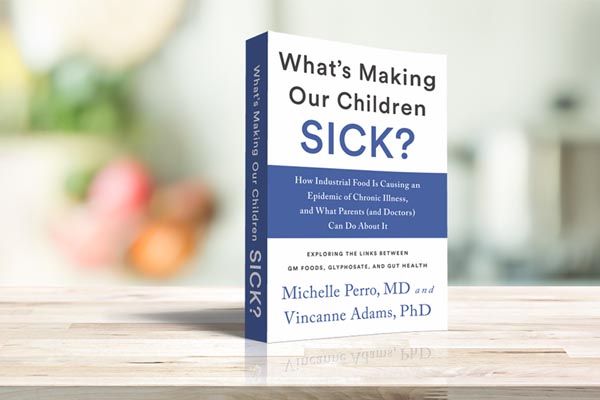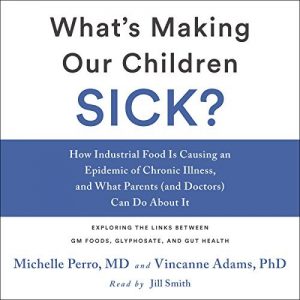May 2, 2018 by Michelle Perro and Vincanne Adams

In a new book What’s Making Our Children Sick? Drs Michelle Perro and Vincanne Adams provide a convincing argument for how industrial food production – including pesticides and GMOs – are combining with other environmental factors to create a ‘perfect storm’ of health problems in kids. Using patient accounts of their clinical experiences and new medical insights about the origins of chronic paediatric disorders – and in particular looking at gut dysfunction – the fully referenced book connects the dots and shows how dietary changes can help address some of the most hard-to-treat disorders that our children suffer from. We excerpt some of the book below.
“What’s making our children sick?” is a question we ask rhetorically, and without arrogance. In this book, we try to answer this question literally, and with humility. Children in the United States – and indeed, all over the world where a Western diet and industrial agriculture reign – are struggling with a new wave of chronic health problems that simply didn’t exist several decades ago.
We are not talking about broken bones and sprains, cuts and bruises, and coughs and colds that we know kids get all the time (some of which can be serious). What we are talking about in this book are chronic health issues that persist over years, problems that require long-term use of medical interventions and don’t ever really go away. We are talking about problems that linger and are managed but have a huge impact on the quality of our kids’ lives and the lives of their families.
Illness on the rise

The authors of this book will be talking about their research and findings in London on May 24. We encourage those who can attend to do so. Tickets are free but places are limited and BOOKING IS ESSENTIAL. Click on the photo above to reserve your place.
What are these problems? Despite enormous strides in protecting the health of our children through medicine and public health, today one in thirteen American children has a serious food allergy, a rate that increased by 50% over the last two decades.
Nearly 9% of our kids have asthma, with dramatic increases in rates from 1980 to today. The prevalence of childhood eczema/atopic dermatitis in the United States is 10.7% overall and as high as 18.1% in individual states – again, a rate that nearly doubled in the past several decades. More than 1.6 million Americans have Crohn’s disease or colitis, and one in ten is a child. One in roughly 140 Americans has celiac disease – a rate that has increased 4.5 times over the past fifty years, with rates increasing among children in particular, and this is before we get to gluten sensitivities.
Gastrointestinal reflux affects 8% of children, and today 10% of infants younger than twelve months with reflux now develop significant complications resulting in a disorder called gastroesophageal reflux disease, or GERD. Irritable bowel syndrome (IBS) occurs in 6 to 24% of kids from middle school through high school. Type 2 diabetes accounted for less than 3% of all cases of new-onset adolescent diabetes up until ten years ago, and now it accounts for 45% of these cases.
One in five American children is now obese. One in forty-one boys and one in sixty-eight children have a diagnosis of autism spectrum disorder, 11% of our children have a diagnosis of attention-deficit/hyperactivity disorder (ADHD), and just over 20% (or one in five) of our children either currently or at some point during their life will have a seriously debilitating mental disorder. These, too, are rates that have skyrocketed over the past two decades. Finally, nearly 60% of our children experience chronic headaches, with 7% of these being chronic migraines.
Looking at disease through a new lens
These numbers are staggering. What is happening to our children? Why are they so sick and with so many chronic, hard-to-treat ailments? Why have these problems shot up among children over the past several decades? What ties them all together?
Might it be that our children are in the midst of a health crisis that has yet to be named, yet to be fully understood? Perhaps we cannot name this crisis because we are looking at these health problems using old and insufficient models of disease and treatment.
In fact, we argue it is possible that some, if not all, of these problems are related to similar underlying sources of pathogenesis (pathways to disease) that affect each child differently yet can be treated by way of some simple, low-tech, integrative medical interventions starting with food.
We believe it is possible to look at health through a new lens that will enable us to tie these chronic health problems together and find a way forward.
Indeed, in this book we posit that the systemic health failures among our children are a result of something even more troubling than the physical symptoms in their bodies; they are the cumulative outcome of being born into and living in an environment that has been made toxic by agrochemical industrialized food production.
A toxic mix
Our children are sick because they are exposed to toxicants in the water, air, furniture, and petrochemical products they use. The amount of common household chemicals in use has been on the rise since World War II despite their known health hazards, and they are largely unregulated.
But more than just toxic chemicals, our children are regularly exposed to toxicants that stress their developing immune systems, organs, and brains in even more insidious ways: through the so-called “healthy” food they eat.
We argue that unless they are eating 100% organic food or homegrown vegetables from ecologically managed soil, they are eating toxic ingredients such as pesticides, hormones, and antibiotics. They are eating foods that are grown with, and contain, ingredients that are harmful to their health.
One reason for this, among many, has been the rise in agrochemical technologies used to grow our food since the mid-1990s, including (though not limited to) use of genetically modified (GM), or genetically engineered (also called transgenic), crops that are designed to be used as, instead of, or in association with pesticides. We call this industrial food. Modern food is industrial food.
Where GMOs fit in
GM technologies, although designed for the opposite outcome, have actually increased toxicants in our food environment. As a result of how we have “improved” our food production systems, our children today are now exposed to and end up consuming more toxic chemicals than any generation before them.
In our book, we gather and present the evidence that the optimistic and necessary intervention to limit our use of pesticides has gone awry and, ironically, led to an increase in toxic exposure and pesticide use. This is having a huge negative impact on our health.
In fact, GM food technologies are likely implicated, directly or indirectly, in the systemic biological problems that underlie many of the chronic ailments that we see in our children today. This includes crops that have been heavily sprayed with pesticides, and foods that have been turned into pesticides due to genetic modification.
While a great deal has been written on the perils of industrial food production on the environment, as well as on the advantages of organic farming, few are connecting the dots between these insights and the health of our future generations.
The role of the gut
Much of our knowledge of what constitutes “healthy food” and a “healthy diet” is changing today. New research on the role of the microbiome in health is forcing us to rethink the role of gut health in relation to overall health, even mental health. And, naturally, efforts to explore gut health are refocusing attention on the role of food in creating and sustaining a healthy microbiome.
As new research on the microbiome grows, however, this could change. That research is telling us that the human gut is perhaps one of the most important keys to health. In fact, some researchers are saying the microbiome itself should be considered a human organ.
Connecting the dots
What has been missing in mainstream conversations and critiques about industrialized food production is a map to connect the dots between the science and the symptoms, the data from animal studies, new knowledge about the microbiology of gut health, and the clinical experiences of doctors who are trying to stay one step ahead of these debilitating problems.
Industrial food production is just beginning to be understood from the perspective of the body’s microbial ecosystem.
Our children have been a living science experiment, and the evidence of its failure is our children’s failing health.
Thankfully, there are leading-edge scientists and clinicians who, along with mothers and fathers of very sick children, are starting to make these connections. By turning to food-focused integrative medicine, people are finding answers and solutions.
Share this page
share using:
Or copy and paste this page address:
https://beyond-gm.org/industrial-food-and-the-epidemic-of-childhood-illness/